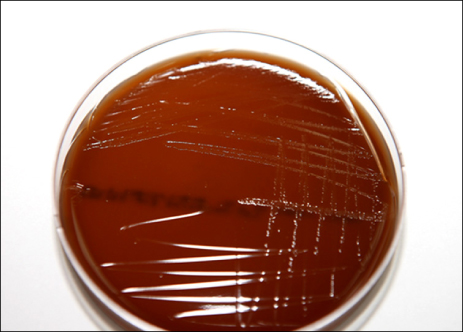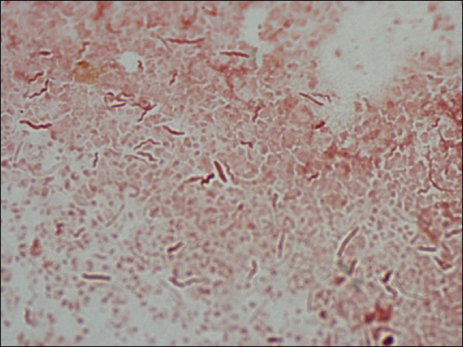Korean J Clin Microbiol.
2012 Jun;15(2):74-77. 10.5145/KJCM.2012.15.2.74.
A Case of Anaerobiospirillum succiniciproducens Isolated from Blood Culture
- Affiliations
-
- 1Department of Laboratory Medicine, Inha University College of Medicine, Incheon, Korea. jkimmd@inha.ac.kr
- 2Department of Laboratory Medicine, Yonsei University College of Medicine, Seoul, Korea.
- KMID: 1434177
- DOI: http://doi.org/10.5145/KJCM.2012.15.2.74
Abstract
- Anaerobiospirillum succiniciproducens is a spiral-shaped, gram-negative anaerobic bacterium. A. succiniciproducens is a rare cause of bacteremia in human, especially immunocompromised patients. This organism may be mistakenly identified when using an automated bacterial identification system, and may be mistaken for Campylobacter spp. when using Gram staining. We report a case of bacteremia caused by A. succiniciproducens, which was negative for catalase, oxidase, and urease and confirmed by 16S rRNA sequencing (analysis revealed a 99% similarity), in a 69-year-old patient who was undergoing chemotherapy for treatment of a malignancy. To the best of our knowledge, this is the first report of bacteremia caused by A. succiniciproducens in Korea.
MeSH Terms
Figure
Reference
-
1. Kelesidis T. Bloodstream infection with Anaerobiospirillum succiniciproducens: a potentially lethal infection. South Med J. 2011. 104:205–214.2. Park Y, Shin HB, Kim CK, Roh KH, Yum JH, Yong D, et al. Identification of bacterial and fungal isolates by sequence analysis of 16S rRNA and internal transcribed spacer. Korean J Clin Microbiol. 2010. 13:34–39.3. Malnick H. Anaerobiospirillum thomasii sp. nov., an anaerobic spiral bacterium isolated from the feces of cats and dogs and from diarrheal feces of humans, and emendation of the genus Anaerobiospirillum. Int J Syst Bacteriol. 1997. 47:381–384.4. Pienaar C, Kruger AJ, Venter EC, Pitout JD. Anaerobiospirillum succiniciproducens bacteraemia. J Clin Pathol. 2003. 56:316–318.5. McNeil MM, Martone WJ, Dowell VR Jr. Bacteremia with Anaerobiospirillum succiniciproducens. Rev Infect Dis. 1987. 9:737–742.6. Tee W, Korman TM, Waters MJ, Macphee A, Jenney A, Joyce L, et al. Three cases of Anaerobiospirillum succiniciproducens bacteremia confirmed by 16S rRNA gene sequencing. J Clin Microbiol. 1998. 36:1209–1213.7. Secchi C, Cantarelli VV, Pereira Fde S, Wolf HH, Brodt TC, Amaro MC, et al. Fatal bacteremia due to Anaerobiospirillum succiniciproducens: first description in Brazil. Braz J Infect Dis. 2005. 9:169–172.8. Fadzilah MN, Faizatul LJ, Hasibah MS, Sam IC, Bador MK, Gan GG, et al. Anaerobiospirillum succiniciproducens bacteraemia in a patient with acute lymphoblastic leukaemia. J Med Microbiol. 2009. 58:142–143.9. Davis CP, Cleven D, Brown J, Balish E. Anaerobiospirillum, a new genus of spiral-shaped bacteria. Int J Syst Bacteriol. 1976. 26:498–504.10. Rifkin GD, Opdyke JE. Anaerobiospirillum succiniciproducens septicemia. J Clin Microbiol. 1981. 13:811–813.11. Mikami Y, Otsuka Y, Sugiura H, Ohkusu K, Ezaki T, Sunaga R, et al. [Anaerobiospirillum succiniciproducens septicemia]. Rinsho Byori. 2007. 55:930–935.12. Malnick H, Williams K, Phil-Ebosie J, Levy AS. Description of a medium for isolating Anaerobiospirillum spp., a possible cause of zoonotic disease, from diarrheal feces and blood of humans and use of the medium in a survey of human, canine, and feline feces. J Clin Microbiol. 1990. 28:1380–1384.13. Goddard WW, Bennett SA, Parkinson C. Anaerobiospirillum succiniciproducens septicaemia: important aspects of diagnosis and management. J Infect. 1998. 37:68–70.
- Full Text Links
- Actions
-
Cited
- CITED
-
- Close
- Share
- Similar articles
-
- Development of Blood Culture and Quality Improvement
- Evaluation of Automated Blood Culture System for Body Fluids Culture Other Than Blood
- Optimal Number of Blood Cultures and Volume of Blood Needed to Detect Bacteremia in Children
- Comparison of Ascitic Fluid Culture Methods for Diagnosing Spontaneous Bacterial Peritonitis
- Analysis of blood culture data in Korea: bacterial distribution and cumulative antimicrobial resistance (2016–2020)



